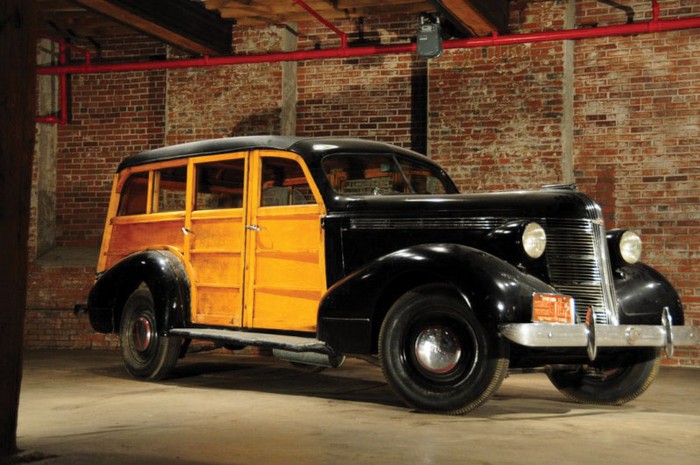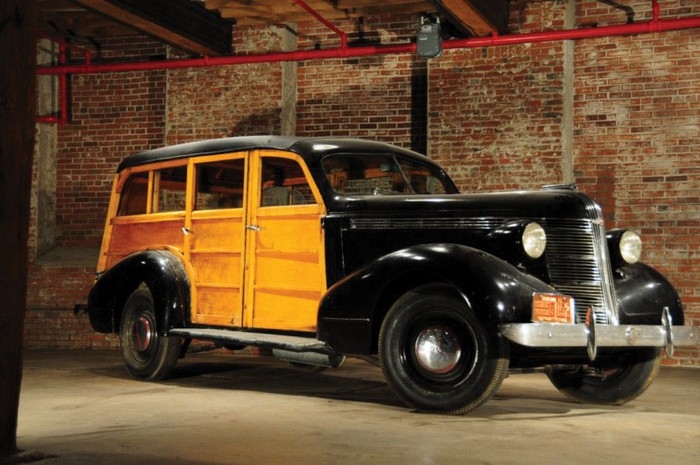
• Reported to have sold new to the Wrigleychewing-gum family in Chicago, 1937
• Sold by Wrigley family in 1977 to family mechanic, then to a collection in Arizona in 1983; stayed there until 2013 in dry storage
• It is said that this rare and interesting woodie is one of four known to exist
• Pontiac is presented as a nearly all-original car with 41,035 miles and fantastic patina
• One repaint in black, newer top, some wood in the rear has been replaced, seat covers redone in the 1980s
• Six-cylinder engine with manual transmission
SCM Analysis
Detailing
| Vehicle: | 1937 Pontiac Deluxe Six Woodie Wagon |
| Years Produced: | 1937 |
| Number Produced: | Approximately 500 |
| Original List Price: | $992 |
| SCM Valuation: | $40,000–$70,000 |
| Tune Up Cost: | $250 |
| Distributor Caps: | $25 |
| Chassis Number Location: | Top of frame ahead of steering gear |
| Engine Number Location: | Left front corner of block |
| Club Info: | National Woodie Club |
| Website: | www.nationalwoodieclub.com |
| Alternatives: | 1939 Ford V8 station wagon, 1937 Plymouth PT 50 station wagon, 1941 Buick Series 49 Estate woodie |
| Investment Grade: | C |
This 1937 Pontiac woodie station wagon, Lot 363, sold for $48,400, including buyer’s premium, at Auctions America’s Spring Carlisle auction, held April 25–26, 2013 in Carlisle, PA.
Prior to the late ’20s, wood station wagons were just utilitarian drivers. Often referred to as Depot Hacks, they provided basic transportation for travelers and their assorted steamer trunks between busy railroad stations and local communities. Automobile manufacturers built the chassis and engines, but the boxy bodies were built by independent body makers such as Ionia, Cantrell, Murray, Hercules and Campbell, among others.
From work to play
By the time the Model A was introduced in 1927, Edsel Ford had his people tracking the sales of custom body firms that were selling depot-hack bodies for Model T chassis. These companies had started to promote similar bodies for the new Model A.
Ford recognized a business opportunity in building his own custom bodies. He’d also just completed “Skylands,” a magnificent 21-room summer home and estate at Seal Harbor, ME. A stylish woodie station wagon, built by Ford, would be just the thing for the caretaker to meet their train when they arrived in their personal parlor car.
In January of 1929 the first Ford station wagons were introduced, but the prototype had been completed in 1928 and was destined for Edsel’s Maine estate.
The estate wagon
By the ’30s, the elegant maple-, oak- and mahogany-bodied woodies elevated from work vehicles to status symbols, as they were more costly to produce than their all-metal counterparts. Often referred to now as estate wagons, they were used at resorts and estates of the well-to-do. In 1937, Ford produced over 9,000 woodie station wagons, and most other manufacturers were adding the prestigious wagons to their catalogs.
Pontiac joined the party midway through the 1937 model year with a 6-cylinder station wagon priced at $992. Pontiac’s slogan, “America’s Finest Low-Priced Car,” was not exactly accurate, as the Ford offering was priced at $755 — almost 25% less than the Pontiac.
Nobody knows how many of these wagons Pontiac produced. One owner has stated he’s been trying to find the number for 18 years. What is known is that fewer than 1,000 were built in 1938, a full year of production. As such, an educated guess would be that fewer than 500 were made, with about four accounted for today. Of the four, however, one has been customized with questionable taste and another has a 454 Chevy V8 under its hood.
This car wears an original Hercules wood body and was reportedly originally sold to the Wrigley family in Chicago. They eventually moved it to their estate in Arizona and kept it there until 1977, when it was sold to one of their mechanics. It sold to another owner in Arizona in 1983.
Since then, it’s been stored in the dry Arizona climate and appears to have been maintained as necessary with nothing altered or modified. It’s had brake and fuel system overhauls but is otherwise still original apart from some upholstery work and an old respray. It wasn’t offered with documentation of the Wrigley family ownership, but even without the paper trail, it still makes for a fascinating tale.
Restore or preserve?
What do you do with this very original, low-mileage Pontiac woodie? Do you restore it, hot-rod it, or leave it alone and drive it?
Sure, it’s one of the only remaining examples of its kind, but restoring it to stock doesn’t make financial sense. A full stock-style restoration would easily consume 1,500 hours of skilled labor. At a very reasonable hourly rate of $75, you’d be about $150,000 into the Pontiac by the time it was ready to be shown. To put that into perspective, a friend of mine recently spent well over a year trying to sell a 1948 Oldsmobile Woodie Six with a back seat full of trophies. He finally settled for less than $75,000. I doubt if this Pontiac would be worth more.
I shudder at the thought of hot-rodding it, as the lines just don’t lend themselves to modification. And the world doesn’t need another woodie with mags, surf stickers, and a crate 350 V8.
So what should the new owner do? Financially, there’s only one answer that makes sense: Leave it alone and drive and display it as a surviving example from another era. If that’s what the new owner has planned, then this was fairly bought and fairly sold at the price paid. Use it for a few years and it’ll likely still pay you back when it comes time to sell. And the best part? Regardless of where you take it, you’ll probably have the only one there.
(Introductory description courtesy of Auctions America.)
